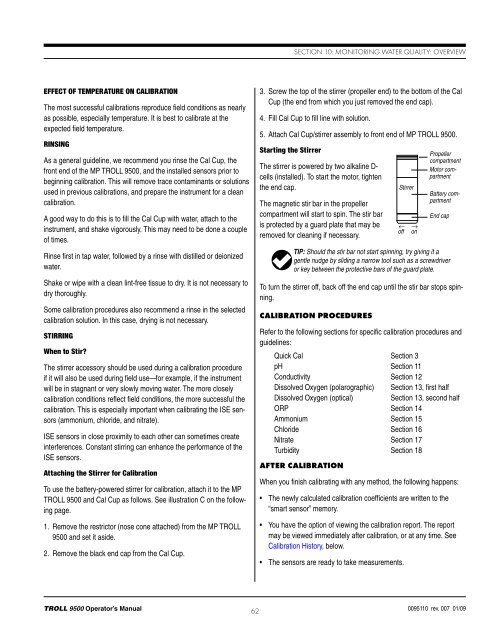TROLL 9500 Operator's Manual - Geotech Environmental Equipment
TROLL 9500 Operator's Manual - Geotech Environmental Equipment
TROLL 9500 Operator's Manual - Geotech Environmental Equipment
You also want an ePaper? Increase the reach of your titles
YUMPU automatically turns print PDFs into web optimized ePapers that Google loves.
Section 10: Monitoring Water Quality: OverviewEffect of Temperature on CalibrationThe most successful calibrations reproduce field conditions as nearlyas possible, especially temperature. It is best to calibrate at theexpected field temperature.RinsingAs a general guideline, we recommend you rinse the Cal Cup, thefront end of the MP <strong>TROLL</strong> <strong>9500</strong>, and the installed sensors prior tobeginning calibration. This will remove trace contaminants or solutionsused in previous calibrations, and prepare the instrument for a cleancalibration.A good way to do this is to fill the Cal Cup with water, attach to theinstrument, and shake vigorously. This may need to be done a coupleof times.Rinse first in tap water, followed by a rinse with distilled or deionizedwater.Shake or wipe with a clean lint-free tissue to dry. It is not necessary todry thoroughly.Some calibration procedures also recommend a rinse in the selectedcalibration solution. In this case, drying is not necessary.StirringWhen to Stir?The stirrer accessory should be used during a calibration procedureif it will also be used during field use—for example, if the instrumentwill be in stagnant or very slowly moving water. The more closelycalibration conditions reflect field conditions, the more successful thecalibration. This is especially important when calibrating the ISE sensors(ammonium, chloride, and nitrate).ISE sensors in close proximity to each other can sometimes createinterferences. Constant stirring can enhance the performance of theISE sensors.Attaching the Stirrer for CalibrationTo use the battery-powered stirrer for calibration, attach it to the MP<strong>TROLL</strong> <strong>9500</strong> and Cal Cup as follows. See illustration C on the followingpage.1. Remove the restrictor (nose cone attached) from the MP <strong>TROLL</strong><strong>9500</strong> and set it aside.2. Remove the black end cap from the Cal Cup.3. Screw the top of the stirrer (propeller end) to the bottom of the CalCup (the end from which you just removed the end cap).4. Fill Cal Cup to fill line with solution.5. Attach Cal Cup/stirrer assembly to front end of MP <strong>TROLL</strong> <strong>9500</strong>.Starting the StirrerThe stirrer is powered by two alkaline D-cells (installed). To start the motor, tightenthe end cap.The magnetic stir bar in the propellercompartment will start to spin. The stir baris protected by a guard plate that may beremoved for cleaning if necessary.Stirrer← →off onPropellercompartmentMotor compartmentBattery compartmentEnd capTIP: Should the stir bar not start spinning, try giving it agentle nudge by sliding a narrow tool such as a screwdriveror key between the protective bars of the guard plate.To turn the stirrer off, back off the end cap until the stir bar stops spinning.Calibration ProceduresRefer to the following sections for specific calibration procedures andguidelines:Quick Cal Section 3pH Section 11Conductivity Section 12Dissolved Oxygen (polarographic) Section 13, first halfDissolved Oxygen (optical)Section 13, second halfORP Section 14Ammonium Section 15Chloride Section 16Nitrate Section 17Turbidity Section 18After CalibrationWhen you finish calibrating with any method, the following happens:• The newly calculated calibration coefficients are written to the“smart sensor” memory.• You have the option of viewing the calibration report. The reportmay be viewed immediately after calibration, or at any time. SeeCalibration History, below.• The sensors are ready to take measurements.<strong>TROLL</strong> <strong>9500</strong> Operator’s <strong>Manual</strong> 620095110 rev. 007 01/09
















